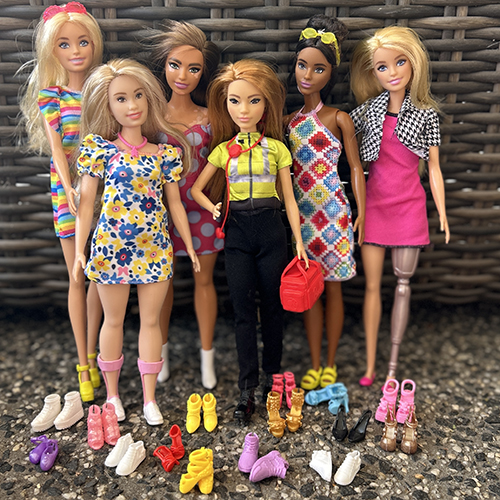15 May 2025
Foot health enthusiasts have researched Barbie’s footwear choices since her debut in the 1950s –and it turns out the iconic doll’s career really took off when she stepped into flatter shoes.
But the study – conducted by Monash University, the University of South Australia and Queen Mary University of London – also found Barbie still loves her high heels, and real women who wear them should not be ‘heel shamed’.
Inspired by the 2023 Barbie movie and published in PLOS One, the project explored correlations and relationships between Barbie’s foot posture, equity/diversity, employment, and time.
The researchers, who included a Barbie collector, audited 2750 Barbie dolls and Barbie Land friends from between 1959 and June 2024.
They used their unique FEET system: Foot posture (flat or equinus [tiptoe]); Equity (diversity and inclusion); Employment (fashion vs employed); and Time period (decade of manufacture).
Over time, the study showed a decreased prevalence in tiptoe foot posture, from 100% in the first period, to 40% in the last.

Author supplied. The Barbie Team (from L to R): Barbie Fashionista (#197) wears an amazing yellow platform heel with ankle straps, Barbie Fashionista (#208) has Down Syndrome and uses sneakers to accommodate her ankle foot orthoses, Barbie Fashionista (#171) wears a high heel white ankle boot and lives with Vitiligo, Barbie Paramedic has her workboots ready to go, Barbie Fashionista (#210) models comfy yellow slides and Barbie Interior Designer wears ballet flats on both her foot and prosthetic limb.
Researchers found that Barbie’s flat foot posture had a very strong positive correlation with employment, and time point, while tiptoe foot posture had a very strong positive correlation with fashion. Similarly, equity (diversity) had a very strong positive correlation with fashion, and strong positive correlation with employment.
Given Barbie is known to reflect societal norms, the researchers contended that this was most likely true for most ‘real life’ high-heel wearers.
“While Barbie has moved with the times, it appears footwear health messaging about high heel wearing needs to catch up,” says senior author, UniSA’s Dr Helen Banwell.
“Health professionals castigating high heels through public messaging should remember that emphasising health benefits consistently drives positive behaviour change, over highlighting negative consequences.
“Barbie clearly makes sensible determinations regarding her body autonomy; high heel wearers should have that same ability.”
First author and Monash University Professor Cylie Williams, a podiatrist and School of Primary and Allied Health Care Deputy Head, says Barbie’s movie meltdown over her feet being flat when she entered the real world inspired the project
“We talked about it, posted on social media and talked to our patients about it,” Prof Williams says
“Then we thought: hang on, has Barbie always been rocking high heels that much? What do her foot postures say about her jobs, how inclusive is she, and has that changed over time?
“While Barbie was working, we observed she was more likely to embrace flat shoes, sneakers and slides. Barbie also had more job roles since the 1990s and increasingly represented people with disabilities and used assistive technology. We saw Barbie in her wheelchair wearing her high heels, while Barbie with an above knee amputation wearing flats to accommodate her prosthesis.
“Barbie wears flats when she’s busy breaking glass ceilings, working in health care or being an athlete. But she still loves her high heels when she's not. Maybe it’s time health messaging caught up. Let’s stop heel-shaming and start empowering people to choose what works for them.”
Dr Helen Banwell, who heads the University of South Australia’s podiatry program, says shoes were a hot topic for podiatrists and some health professionals were toey about high heels.
“Most foot problems happen to people not in heels, yet high heels get blamed for everything from bunions to bad moods,” Dr Banwell says.
“This study let us unpack the myths, celebrate informed choices, and see how a global icon like Barbie reflects (or challenges) social norms. Also, research can be fun, and it was way more fun when Barbie was involved.
“Barbie clearly has body autonomy – so should everyone else. And if so, if high heel wearers want to rock a stiletto, we propose they are already aware of how they feel and how they can move in them. Let's leave health messing to things that have a higher impact on health behaviours.
“It is time we recognised that high-heel wearers, including Barbie as a socially constructed representative woman, make sensible choices based on what works for them.”
Dr Kristin Graham, who is a senior lecturer at UniSA’s podiatry program, says research on wearing high heels was scant, but we know wearing high heels makes you walk slower, and the higher the heel height, the more instability, pain and possible injury risks.
As a result, she says many health professionals discouraged high heeled footwear, often linking it to bunions, knee osteoarthritis, plantar fasciitis and low back pain. Yet many of these health conditions were prevalent in the general population regardless of preferred heel height
“We don't know that there is a direct impact on long term foot and leg health,” Dr Graham says.
“This is because it's never been studied in detail or over time, and because people who wear high heels often wear them for a different length of time each day, or interchangeably with flat shoes.
“We do know many of the things that people attribute to high heel wear, including tight calf muscles, bunions and heel pain, can happen in people who don't wear high heels. So, while there might be a risk, we only know what the risk is while they are being worn, and it's a variable risk because of how variable high heels actually are both in shape and height.”
.................................................................................................................................
Media contacts:
UniSA: Annabel Mansfield E: Annabel.Mansfield@unisa.edu.au M: +61 479 182 489
Monash University: Cheryl Critchley E: cheryl.critchley@monash.edu M: +61 477 571 442



